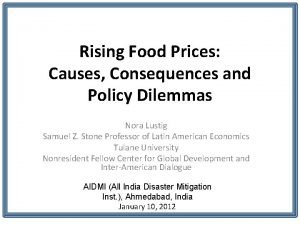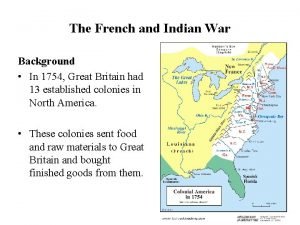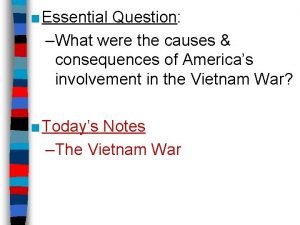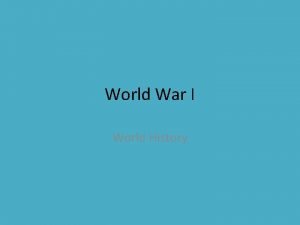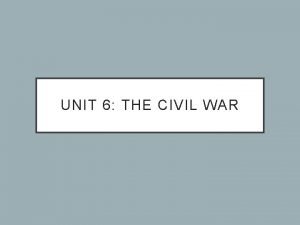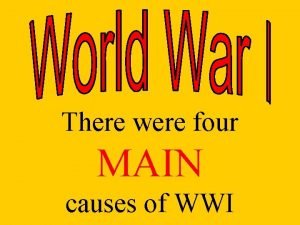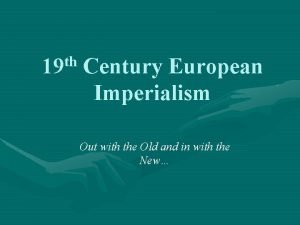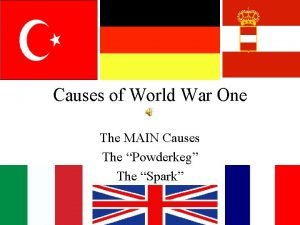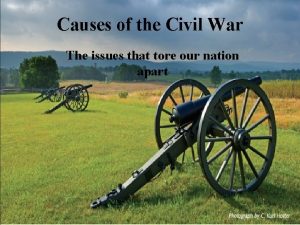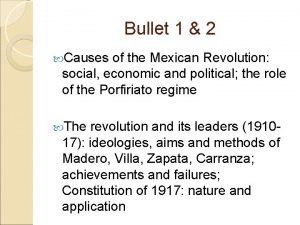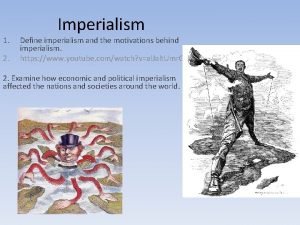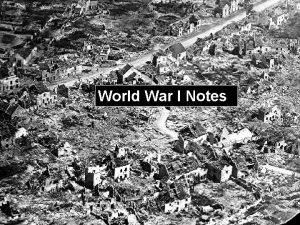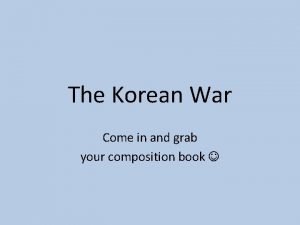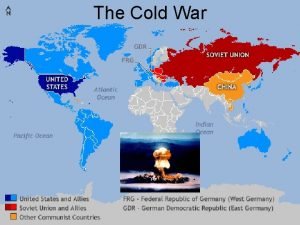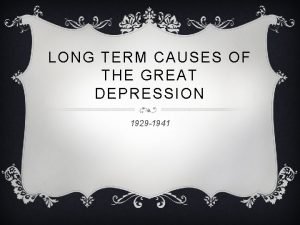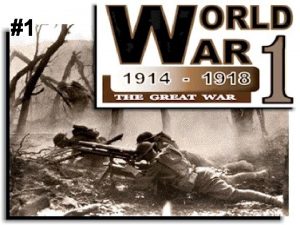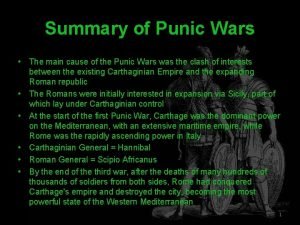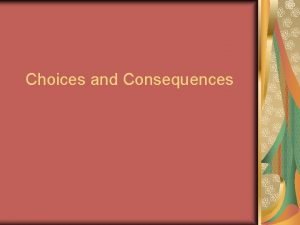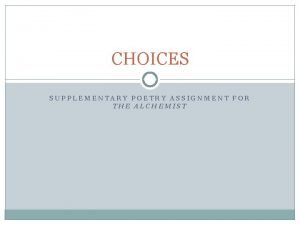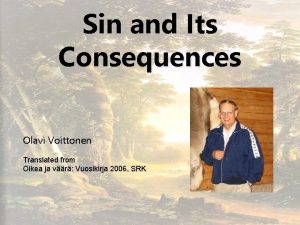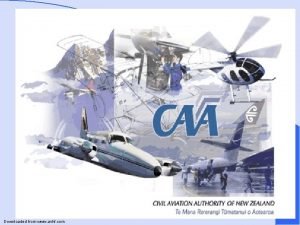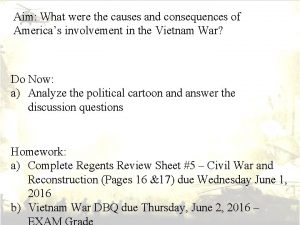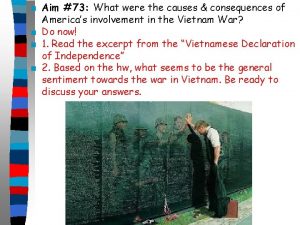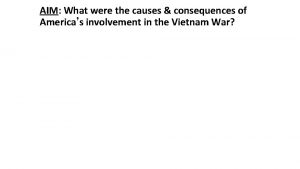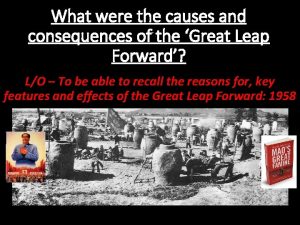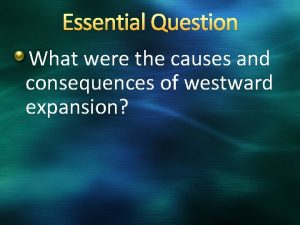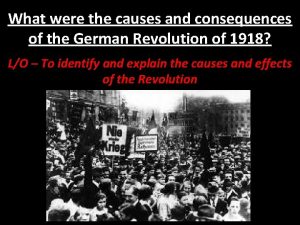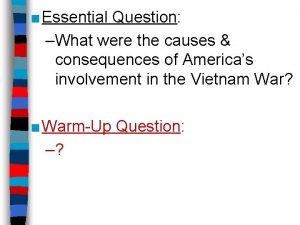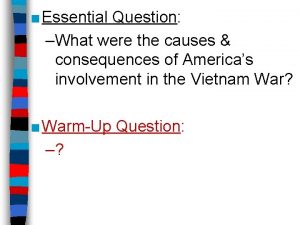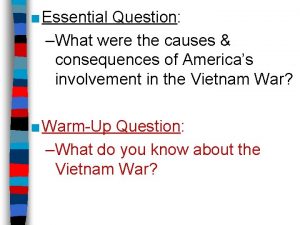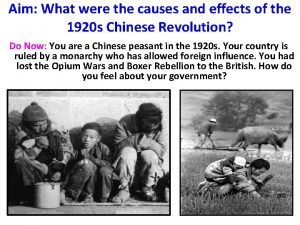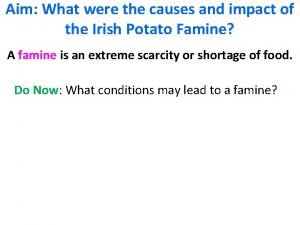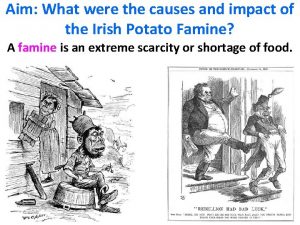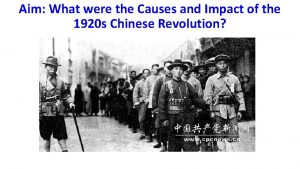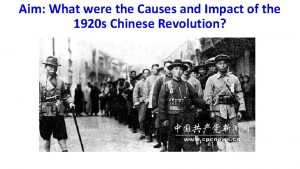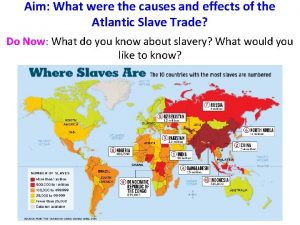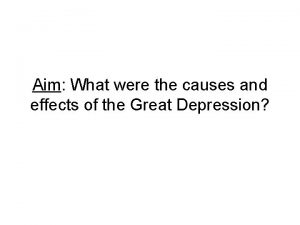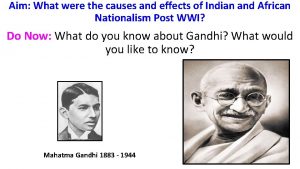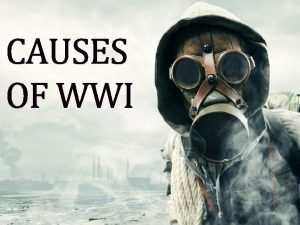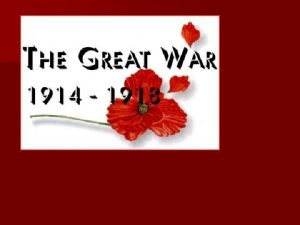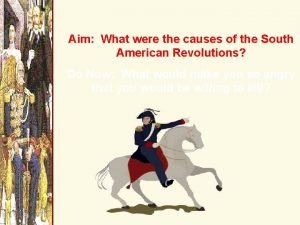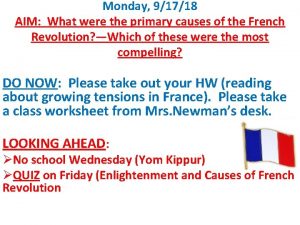Aim What were the Causes and Consequences of


























- Slides: 26

Aim: What were the Causes and Consequences of the Russian Revolutions? Do Now: What do you know about the Russian Revolutions? What do you want to know?


I Russian Revolution 1905 Long Term Causes: ü Autocratic government under Czar Nicholas II ü Poor industrialization compared to the West ü Poverty Short Term Causes: ü Defeat by Japan in Russo-Japanese War (Feb 8, 1904 – Sep 5, 1905) over control of Manchuria in Northeast China and Korea ü Bloody Sunday (coming up!)

Russian Peasants Demand for Bread Lead to the 1905 Revolution

Russian Revolution 1905 Continued… Bloody Sunday: Sunday, January 22, 1905, a march occurred in St. Petersburg demanding reform. Czar Nicholas II called in soldiers 28 unarmed civilians were shot. 14 died.

Trans-Siberian Railroad: An Attempt to Modernize Russia

Czar Nicholas II

Consequences of the 1905 Revolution A) Czar Nicholas II made reforms: granted freedom of conscience, speech & meeting. No imprisonment without trial. B) Established the Duma, which must approve all laws. C) Nicholas II dissolved the 1 st Duma when its leaders criticized the government. D) New voting laws limited powers of the later Dumas.

II Russian Revolution 1917 A) The February Revolution began March 8, 1917 (or February 23 on the Julian calendar), when demonstrators demanded bread in Petrograd (St. Petersburg). March 11, Petrograd troops were called to stop the riots, and Nicholas again dissolved the Duma.

Russian Revolution 1917 Continued… B) March 15, Czar Nicholas II abdicated the throne, ending czarist rule of Russia! C) Power was shared between the weak temporary government and the Petrograd Soviet (the city council of Petrograd). November 6 and 7, 1917 (or October 24 and 25 on the Julian calendar, which is why this event is also called the October Revolution), revolutionaries led by Bolshevik Party leader Vladimir Lenin launched a coup. The Bolsheviks formed a new government with Lenin as its head.

October Revolution Soldiers loyal to the Bolsheviks took positions outside the Winter Palace, the residence of the czar and his family

Rasputin “The Mad Monk” Rasputin, a Siberian-born peasant, proclaimed himself a healer and pyshic, won the favor of Czar Nicholas II and Czarina Alexandra through his ability to stop the bleeding of their hemophiliac son, Alexei. He particularly influenced the czarina, and was rumored to be her lover. When Nicholas departed to lead Russian forces in WWI, Rasputin effectively ruled the country through Alexandra, . Fearful of Rasputin’s growing power, a group of nobles lured Rasputin to Youssupov Palace on December 29, 1916. First, Rasputin’s wouldbe killers gave the monk food and wine laced with cyanide. When he failed to react to the poison, they shot him at close range, leaving him for dead. A short time later, Rasputin revived and attempted to escape, whereupon his assailants shot him again and beat him. Finally, they bound Rasputin, still alive, and tossed him into a freezing river. His body was discovered several days later and the two main conspirators were exiled. Not long after, the Bolshevik Revolution put an end to the imperial regime. Nicholas and Alexandra were murdered, and the long, dark reign of the Romanovs

Czar Nicholas II and His Family “Against the backdrop of WWI and the February and October revolutions, the Czar and his family were initially kept as prisoners near St. Petersburg and then transported to Ekaterinburg (beyond the Ural Mountains) in 1918, and confined to a house. By mid. July a Czech contingent of the White Army was approaching Ekaterinburg and the sounds of gun fire could be heard in the distance by the royal prisoners and their Bolshevik captors. On the morning of July 17 the Czar, his wife, children and servants were herded into the cellar of their prison house and executed. ” – www. eyewitnesstohistory. com

After the October Revolution was Civil War A "Red" Army unit (loyal to the Bolsheviks) marched through Kharkov. In order to secure control over the entire country, Lenin and his supporters had to wage a 4 year war against the "Whites, " a coaltion of all who opposed them.

D) Lenin became the dictator of the first Marxist state in the world. He made peace with Germany, nationalized industry and distributed land. 1918 he had to fight a civil war against the anti-Bolshevik White Army. 1920, the anti-Bolsheviks were defeated. 1922 the Union of Soviet Socialist Republics (USSR) was established. “The oppressed are allowed once every few years to decide which particular representatives of the oppressing class are to represent them and repress them in parliament. ” – Vladimir Lenin


Revolution in Russia 1917 Continued… H) 1920 Lenin began his New Economic Policy, which allowed some private ownership to exist under a centralized leadership. The plan helped farmers economically, but many farmers were against the modernization required to successfully implement this program.

III Rise of Stalin A) Lenin died in 1924 struggle for power between Leon Trotsky and Joseph Stalin. Trotsky: the Communist Party should spread socialist revolutions around the world. Stalin: The Communist Party should promote internal development instead. 1928 Stalin exiled Trotsky. B) Stalin replaced Lenin’s New Economic Policy with collective farms that were state run, eliminating private land ownership. Resisters were forced to move to labor camps in Siberia. With the agricultural surplus from the farms, Stalin established his Five Year Plan, which set ambitious goals for production of heavy industry, such as oil, steel, and electricity. The government decided what, how and how much was produced, as well as who would be the recipients, over the course of a 5 year period.

In January 1928, Leon Trotsky was deported by Joseph Stalin to remote Soviet Central Asia for a year before being banished from the USSR forever by Stalin. Aug 20, 1940 Trotsky was assassinated with an ice axe at his compound outside Mexico City. Joseph Stalin (1878 -1953) was the dictator of the USSR from 1929 to 1953. Under Stalin, the USSR was transformed from a peasant society into an industrial and military superpower, although he murdered millions who resisted.



Stalin’s 5 Year Plan A gulag; a Siberian Labor Camp

Collectivization and Famine in Ukraine was incorporated into the USSR in 1922. To pacify the Ukrainians, Moscow initially permitted some local autonomy to exist in the USSR. The Ukrainian Orthodox Church was permitted. In Stalin's eyes, Ukraine, the largest of the non-Russian republics, would have to be subdued. The Ukrainian Church was placed under the authority of the communist controlled Russian Orthodox Church. Thousands of Ukrainian clergy and secular intellectuals were sent to the gulags (labor camps in Siberia). Kulaks (Ukrainian farm land owners) were forced to collectivize their farms. Over 200, 000 Ukrainian families were dispossessed of their land. Ukraine was the breadbasket of the USSR, and Stalin wanted to modernize farming and greatly increase crop production. To do this, farmers were given quotas. Many resisted, some violently; thousands were killed and millions were sent to the gulags. The Soviets sealed off the borders of Ukraine, preventing any food from entering. Bodies were dumped in mass graves. By the end of 1933, nearly 25% of the population of Ukraine, including three million children, had perished. http: //www. historyplace. com/worldhistory/genocide/stalin. htm http: //www. ukrainiangenocide. org/

Famine in Ukraine

Summary Questions 1. Explain the long and short term causes for the 1905 Russian Revolution. 2. Explain the long and short term causes for the 1917 Russian Revolutions. 3. How did Lenin come to power? How did Stalin come to power? 4. Do you agree more with Lenin or Stalin’s style of rule? Justify your answer with evidence. 5. Briefly describe Stalin’s actions in the Ukraine. Were his actions justified?

Key Vocabulary Bolshevik Party Bourgeoisie Collective farms Czar Alexander II Duma February Revolution Five Year Plan Joseph Stalin Kulaks Lenin’s New Economic Policy Leon Trotsky Marxism October Revolution Petrograd Proletariat Rasputin Ukraine USSR White Army
 Rising food prices causes and consequences
Rising food prices causes and consequences Causes of the persian war
Causes of the persian war A new beginning in french
A new beginning in french What was the causes of the french and indian war
What was the causes of the french and indian war What were the causes and effects of the vietnam war
What were the causes and effects of the vietnam war Proximate and ultimate causes of behaviour
Proximate and ultimate causes of behaviour Proximate causes vs ultimate causes
Proximate causes vs ultimate causes Future in past
Future in past Cause of colonialism
Cause of colonialism North vs south civil war comparison chart
North vs south civil war comparison chart What were the main reasons for ww1
What were the main reasons for ww1 What were the causes of imperialism
What were the causes of imperialism M.a.i.n ww1
M.a.i.n ww1 What were the 4 main causes of the civil war
What were the 4 main causes of the civil war What were the causes of the mexican revolution
What were the causes of the mexican revolution Causes of imperialism
Causes of imperialism Mania in ww1
Mania in ww1 Causes of the korean war
Causes of the korean war Cause of korean war
Cause of korean war What were the long term causes of the great depression
What were the long term causes of the great depression Central powers wwi
Central powers wwi Summary of the punic wars
Summary of the punic wars Okonkwo's violent acts and consequences part 1
Okonkwo's violent acts and consequences part 1 Objective consequences
Objective consequences Hard choices jojoba mansell
Hard choices jojoba mansell Olavi voittonen
Olavi voittonen Aviation hazardous attitudes
Aviation hazardous attitudes
